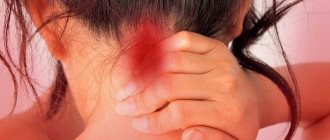Pressing cephalalgia in the temples can occur at any time of the day. This pain is usually of mild or moderate intensity. It does not always indicate the presence of diseases or serious problems, but if it appears systematically, it requires diagnosis. There are many effective ways to deal with unpleasant sensations of a physiological nature. If their use does not give the desired result, you should not resort to taking medications. It is better to visit a neurologist who will determine the causes of the condition and select the necessary treatment regimen. You should not delay your visit to the doctor if there is pressure in your temples and additional alarming symptoms appear.
The mechanism of pain in the temples of any nature
In the temporal areas of the head there is a dense vascular network. Due to the anatomical features of the area, the blood channels are located in close proximity to both the skin and bones of the skull. If for some reason cephalalgia spreads to this area, it is in most cases caused by a circulatory failure, increased blood flow to the tissues, and vasospasm. Even arteritis, in which there is not only pressure in the temples, but also sharp or pulsating sensations, is no exception. It is accompanied by cephalalgia due to irritation of receptors by increased blood pressure.
Temples hurt - what are the reasons?
The triggers for temporal cephalgia are not necessarily in the head. Pressing sensations can occur at the initial stage of a cold, in case of poisoning with toxic fumes or salts of heavy metals. Often the symptom is not pathological, but physiological in origin.
Factors that cause headaches and noticeable pressure on the temples:
- stress – experiences, emotional overload, shock situations lead to vasospasm, hypoxia of the brain matter. Analgesics will not help here; it is better to use relaxation techniques or natural sedatives;
- physical overload – passion for sports creates excessive stress on the blood vessels. Due to the peculiarities of the anatomy, pressing pain first occurs in the temples. Adjusting your training regimen will relieve discomfort;
- alcohol consumption - even in small volumes, alcoholic drinks become a source of toxins and cause changes in the tone of blood channels. Temporal cephalgia can occur both with alcohol abuse and after a single dose;
- smoking is a factor that causes vascular spasm, causing an increase in blood pressure. Heavy smokers not only experience pressure on their temples, but the pain spreads to the entire cranium. If there is no opportunity or desire to give up the habit, you must at least follow the rules of smoking;
- changes in hormonal levels - unpleasant sensations in the temples often bother women during menopause, menopause, pregnancy, menstruation or before them. They are usually mild and easily treatable using traditional medicine;
- change in climatic conditions - a violent reaction to weather changes often indicates reduced functionality of blood vessels. If treatment is not required, it is worth at least doing general strengthening of the body;
- dietary habits - eating fatty or fried foods threatens vascular atherosclerosis. Excessive consumption of salty foods can lead to hypertension. A passion for processed foods, fast food and preservatives leads to the accumulation of chemical additives in the body, to which the brain reacts with a headache in the temples;
- eye strain – prolonged work at the computer or with papers, reading, looking at small details force the eye muscles to overstrain. The result is a decrease in visual acuity, dryness and redness of the mucous membrane, pressing sensations in the temples;
- non-compliance with the daily routine - temporal cephalgia is one of the first and most striking symptoms of lack of sleep or excess sleep. Correcting your routine will quickly relieve discomfort.
When physiological causes can be excluded, it is worth visiting a therapist. The regular occurrence of a symptom is characteristic of a number of pathological conditions that can pose a threat to health. Do not hesitate to visit a doctor if your headache is accompanied by other warning signs.
Hypertonic disease
With a persistent increase in blood pressure, people can experience cephalalgia constantly or suffer from systematic prolonged attacks.
They have a headache in the temple area, and the sensation often moves to the back of the head. Soreness is represented by pressure or distension, which at its peak turns into pulsation. The clinical picture is complemented by facial redness, irritability, dizziness, loss of coordination, and nausea. The danger of the disease is that it negatively affects the condition of the blood vessels and leads to their wear and tear. Hypertension also puts excessive strain on the heart. If left untreated, the disease can provoke a hypertensive crisis, stroke, and multiple organ failure.
Migraine
Neurological pathology is characterized by unilateral headache in the temples, which gradually spreads to the entire half of the skull. From time to time the symptom may change its localization to the opposite, but rarely becomes symmetrical. At the peak of sensations, the pressure turns into pulsation. It is accompanied by nausea - if vomiting occurs, the patient experiences relief. An attack of cephalgia in a quarter of cases is preceded by an aura in the form of unusual visual, olfactory, and tactile sensations. During physical activity, under the influence of smells, sounds, bright light, the discomfort intensifies.
Cardiopsychoneurosis
The cause of this disease has not yet been fully established. Its development is associated with the specifics of the constitution
person. According to statistics, pathology is detected in young people. It is manifested by cephalalgia, decreased temperature of the extremities, spots before the eyes, a lump in the throat and pain in the chest, which is relieved by Nitroglycerin. The headache is pressing, mainly concentrated in the temples.
Most patients diagnosed experience occasional crises. They are characterized by dizziness, bouts of trembling, inexplicable fear, and increased sweating. Such attacks are resolved by loose stools or copious urine output.
Transitory reasons
This group includes passing factors that cause a one-time occurrence of a symptom. They are usually not dangerous, but can cause discomfort. When systematically exposed to the body, such irritants can provoke the appearance of chronic problems. The list includes abuse of coffee or other stimulants, taking medications, fear, uncomfortable headwear, inappropriate hairstyle, and hypothermia of the head. If you try to endure such pain, then under the influence of negative emotions it will only intensify.
Diagnostics
Depending on the symptoms that accompany hot flashes to the head, the patient is prescribed a consultation with an endocrinologist, neurologist, or cardiologist. During the initial examination, the doctor asks how long the attacks have been bothering you, how often they appear and what is triggered. The specialist conducts a physical examination, measures blood pressure and heart rate, and listens to heart sounds. The plan of laboratory and instrumental diagnostic studies includes:
- Neurological examination
. The specialist checks the basic deep and superficial reflexes and their symmetry. Using special tests and questionnaires, it establishes the correct functioning of the autonomic nervous system. If an organic lesion of the central nervous system is suspected, an EEG, CT or MRI of the brain is performed. - ECG.
A quick and non-invasive method is used to detect heart pathology. Based on the results of the cardiogram, the doctor diagnoses myocardial hypertrophy, arrhythmia, conduction disorders - the causes that cause hot flashes. To clarify the diagnosis, echocardiography is recommended; in rare cases, invasive coronary angiography is indicated. - Blood tests
. The level of cortisol, adrenaline, thyroxine and other hormones that contribute to a rush of blood and heat to the head are assessed. Women undergo an extended hormonal profile with the determination of estrogens, progesterone, FSH and LH. In men, the amount of testosterone is measured. Be sure to analyze the results of the lipid profile.
In case of possible endocrine disorders, the results of ultrasound of the adrenal glands and thyroid gland are taken into account. To assess the emotional state and exclude various phobias and neuroses that cause hot flashes, a consultation with a psychiatrist is required. Women of reproductive age who regularly experience paroxysms should visit a gynecologist - sometimes hot flashes develop due to dysfunction of the reproductive organs.
Dosed physical activity improves autonomic regulation
Diagnostic algorithm
At the initial stage of development of many diseases and with physiological causes of temporal headache, the symptom is often the only alarming sign. Based on this, it is difficult to make a diagnosis and choose the right treatment. After collecting anamnesis, a number of steps should be taken to help determine the source of the problems.
If you experience pain in your temples, it is recommended to do the following:
- measure blood pressure - each person has his own “working pressure” at which he feels comfortable. It is important to understand that indicators exceeding these limits are not considered a disease if they are within the boundaries of medical norms. Attempts to correct normal blood pressure readings using pills can lead to serious problems;
- assess the likelihood of external factors influencing the body;
- pass general tests, undergo diagnostic procedures. The list of the latter is established by the doctor. For pressing sensations in the temples, MRI, CT, ultrasound or REG of blood vessels, and EEG are often used.
Based on the research results, the doctor makes a preliminary diagnosis. If necessary, he refers the patient for examination to a neurologist, ophthalmologist, ENT specialist, psychologist, orthopedist or other specialist. After identifying the causes of the headache, a treatment regimen is selected for the patient.
Treatment methods
It is important to start treatment promptly if attacks occur frequently or are of high intensity. The regimen includes several steps aimed at eliminating the cause and symptoms of headaches and dizziness.
- The first stage is relief of an attack of acute pain. For this purpose, analgesics, antiemetics, and antihistamines are prescribed.
- The second stage involves systemic treatment of the underlying cause of the attacks. The doctor will select a suitable regimen to support the functioning of the gastrointestinal tract, heart and blood vessels, and endocrine glands.
- For pathologies of the cervical spine, non-drug methods are effective. Treatment methods such as massage, gymnastics, and physiotherapy may be prescribed.
- For migraines, conventional painkillers do not provide relief. After confirming the diagnosis, the doctor will prescribe medications from the triptan group (sumatriptan).
- To restore balance, a set of exercises that can be performed at home is effective. It includes turning the head while stopping the gaze at a certain point, walking with eyes closed, and standing on one leg.
If you have a headache, feel sick, feel dizzy, or feel weak, you should definitely consult a doctor and start treating the problem. The Clinical Brain Institute offers comprehensive programs for diagnosing and treating headaches. Here you have the opportunity to undergo a full examination by experienced specialists and receive the most effective recommendations. Treatment takes place under the full supervision of general and specialized doctors, using new techniques and modern equipment.
Clinical Brain Institute Rating: 4/5 — 16 votes
Share article on social networks
Temples hurt - what to do?
In case of a one-time occurrence of unpleasant sensations of mild or moderate severity, you can try to cope with the problem yourself. Sometimes, to eliminate discomfort, it is enough to take a walk in the fresh air, drink a cup of chamomile tea, massage your temples, or rub a drop of menthol oil into them. If you still have a headache in your temples after this, you can take a tablet of Ibuprofen, Paracetamol or Citramon.
In other cases, the treatment method depends on the causes of cephalgia:
- hypertension - diet, taking antihypertensive drugs, removing excess fluid from the body, restoring vascular patency, improving blood circulation in the brain;
- migraine – pain relief with the help of NSAIDs, analgesics, triptans, ergotamines;
- neurocirculatory dystonia - taking natural sedatives or light tranquilizers in case of their low effectiveness.
- transient causes - elimination of the irritant, pain relief with any available medications.
Once the discomfort has been eliminated, the treatment does not end. It is necessary to select an appropriate method of preventing temporal cephalgia so that attacks do not recur.
Prevention of pathological condition
Help prevent headaches:
- Elimination of harmful products.
- Complete rest.
- Ventilation of the room.
- Self-massage of the head.
- Compresses with essential oils.
- Herbal decoctions.
Did you like the article? Save it!
Still have questions? Ask them in the comments! Cardiologist Mariam Harutyunyan will answer them.
Ivan Grekhov
Graduated from the Ural State Medical University with a degree in General Medicine. General practitioner








